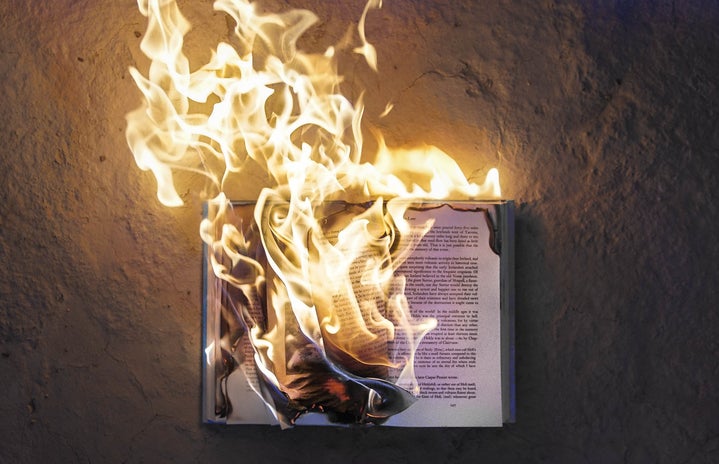It’s funny how the land of the free is so afraid of freedom. I’m talking, of course, about the freedom to read, to learn, to question and to educate. For a nation founded on the principle of challenge, the cry of rebellion, the demand for question, we’re awfully good at making sure none of those things happens. One has to ask, have we become the very empire we fought to free ourselves from? But that’s a different conversation.
The U.S. history of banned books dates back to 1637 with Thomas Morton. Morton crossed the sea to live in the Puritan society in Massachusetts. He quickly left, disagreeing with the Puritans strict rules and old world values. He began his own colony in Quincy, Massachusetts. It was here that he wrote and published what would soon become what is thought of as the first banned book in the US. His novel The New English Canaan was published in 1637 and quickly banned by the Puritans for its harsh critique of Puritan customs.
The next period of censorship occurred nearly 200 years later during the Civil War with Harriet Beechers infamous Uncle Tom’s Cabin. It was burned and banned along with other anti-slavery books that circled around the South. It’s important to note, however, that the South was not alone in their campaign to ban books that sprouted opposing views. The North banned pro-South literature such as biographies about southern generals.
On top of religion and opposing viewpoints, immorality became the next claim to fame when it came to book banning. In 1873, the Comstock Act was passed, making it illegal to possess any texts or articles that were deemed obscene or immoral. Unsurprisingly, these texts tended to target books based on sexuality and contraception. The law went on to criminalize activities promoting or providing birth control or contraception as well as discussion about sexuality. It was only overturned in 1936. An interesting note: during this time, Boston became a hotbed for book banning and many authors INTENTIONALLY printed their books in Boston, hoping they would be banned in an attempt to give them a public boost and interest elsewhere. Ironic really.
The banning continued throughout the following years, often challenging books that questioned social norms or taught American history. In 1969, in Tinker v Des Moines, the Supreme Court declared that teachers and students had a right to read whatever they chose, arguing it was part of freedom of speech. Later, in 1982, in Island Trees Union Free School District v Pico, they ruled that school boards could not remove books from school libraries because they disagreed with the ideas or messages they advocated for. Students had protested the removal of books from their libraries that they deemed “anti-American, anti-Christian, and anti-Semitic.” Despite these rulings, we find ourselves facing a host of banned books today. In the span of nine months between July 1, 2021 and March 31, 2022, 1,586 books were banned across 26 states. For those of you keeping track, that’s 176 books a month, or almost 44 books a week. These books range from discussions around LGBTQIA+ issues to books on death and grief. It seems nothing is safe from the stamp of censorship.
Unfortunately, this issue is not limited to the border of the U.S. It has a long history worldwide from the Conquistadors to the Nazi’s, book banning (and burning) has often been a popular form of censorship designed to influence and control the public.
I’ve written this article in hopes that something falls through the cracks. If we keep talking and writing and reading and opposing, maybe we can stop this train wreck of suppression before it goes off the rails.
To begin, I’d like us to take a moment to discuss the danger the act of banning books poses to our society.
First and foremost, it’s important to note that banning books is a form of censorship. And censorship is a form of control. How so? Banning books is often done in the name of protection for its citizens. To this, I say books are a fountain of information and knowledge. They cannot be censored, edited, or blocked like pages on the world wide web can be. They provide information, history and ideas. If people lack access to these books, they lack access to their information. And without this information, it is difficult to challenge the systems of power. If you do not know that there is a different way of doing things–a different way of thinking, believing, and living–how are you possibly going to challenge what already exists? If it is all you know, how can you pursue a different vision? If the flow of information is controlled – if the people have access only to what you want them to have access to, you control them. You cannot have a free world without free knowledge.
Secondly, banning books silences voices. And unfortunately, it tends to silence the voices of marginalized groups. Commonly targeted books tend to be those written by and about communities that have been (and continue to be) pushed to the margins of our society. These books include-but are not limited to-the stories of LGBTQIA+, disabled, non-Christian, lower class, non-English speaking communities as well as communities of color. By banning books that target these communities, we effectively remove their voice from the narrative of our society. We remove their ideas, perspectives, and histories. And what’s left is a white-washed, rich narrative that tells one story.
Thirdly and finally, we lose our history. Many banned books discuss topics such as the history of colonialism, the Holocaust, the enslavement and genocide of indigenous people and other communities of color, and historic and contemporary discrimination. Many have been banned in the name of “protecting our children,” specifically, our privileged children. Now, I’m not advocating for sitting a 7-year-old down, opening a textbook, and going into deep detail about how colonists in America effectively raped, murdered, and tortured an entire indigenous population in the name of progress, but what I am advocating for is that this information be presented fully and honestly at the appropriate level and time. Facing our past is difficult. Admitting and amending our wrongs takes courage. But if we don’t know our history, don’t understand it, and don’t acknowledge it…what is going to stop us from repeating it? If we don’t remember the atrocity and name it for what it was, what’s stopping future generations from repeating them? We can celebrate our past while acknowledging its wrongs. We can celebrate George Washington for his bravery while condemning his actions towards minority groups. We can give credit to Henry Ford for his invention of the assembly line while denouncing his anti-semetic views and actions. History is complex, just as human beings are. If we lose that complexity, we lose our truth and we will be forced to repeat our most horrific mistakes because no one was there to remember them and warn us.
So what, then, is the solution? It is my personal belief that no book should be banned. Instead, books should be framed with context. Let people read anything and everything while providing solid, easy to understand, educational material on why the contents of the book are harmful or should not be repeated. That second part is KEY. Education, education, education. We must let our people know why ideas or actions or even events in history are dangerous, harmful, or flat out wrong. We must read about and understand anti-semitism to be able to recognize it when it’s on the rise AND we must be educated on why it’s a harmful and hateful idea. We must read about and understand historical acts of genocide so we can recognize them today AND we must be educated on why it was devastating and a horrendous movement that must not be repeated.
You may ask yourself, who is the decider of what we condemn and what we celebrate? To this I ask you: if we are pushing to celebrate a moment in history, a view point, an ideology that is built and bred on hate, discrimination and death…should we really be celebrating it?
Information is dangerous but it is so important. If we cannot learn about and understand the harmful, difficult and painful things in our world, how will we recognize it in our present day in time to fight it?
With all that being said, if you find you have a desire to read these banned/challenged books, I hope this list helps.
A quick note. A challenged book is a book that has faced attempts at its removal or its restriction due to the objections of some person and/or group. A banned book is a book that has officially been removed or restricted. The below list included both challenged and banned book.
To see a full list of the 100 Most Banned Books from 2010 to 2019, check out the American Library Association’s website here.
You can find these titles on Amazon or Barnes and Noble’s website. Tattered Cover is also a great choice. Or, check out your local library or mom and pop bookstore.
Now, without further ado: some of the most challenged/banned books to date.
The book was banned for profanity and several scenes that were deemed sexually explicit (the book contains kissing and sexual thoughts as well as mentions of masturbation). The book details the experience of a young Native American boy who leaves the reservation to join an all white-boy’s school. The story addresses themes of racial identity, poverty, violence, coming of age and draws from Alexie’s own experiences.
These books have been challenged and banned often by parents of elementary schoolers who feel they might be too scary for the age group or that they might lead to violent thoughts and actions. The series details short, spooky stories designed for children seeking a thrill and gained immense popularity, holding the No. 1 seller spot before the emergence of a certain English wizard. Opponents to the ban have pointed out that children can choose to simply not read the books…as for violent thoughts and actions, I feel we should be more concerned about what children are seeing on the never-ending news feed and social media streams rather than the boogeyman in their library book.
The book tells the story of a young African-American girl, Pecola Breedlove, who grows up in Lorain, Ohio where she dreams of whiter skin and bluer eyes so that she might be “pretty.” Pecola grows up in a violent household where her parents constantly fight and she is eventually raped and impregnated by her father. The book was challenged and banned because it contained “sexually explicit material”, “an underlying socialist and communist agenda” and “disturbing imagery.” Yes, the themes in the book are mature and difficult to read but that doesn’t mean it should be banned. Life is difficult and filled with challenges. Literature is a tool we can use to feel connected through this difficulty; to feel seen if we experience similar issues or to feel empathy if we seek to learn about them. Difficulty should not be banned.
The book was challenged initially because of its cover, which depicts two boys kissing, never mind the thousands of romance novels depicting heterosexual couples kissing. It was later challenged because it was deemed to include “sexually explicit LGBT content.” So…yeah. It tells the based-on-a-true-story of two boys who decide to take part in a marathon of kissing to set a new Guinness World Record. As they continue their 32 hour marathon of kissing, they explore their own feelings towards each other as well as become a focal point in the lives and stories of other boys who are trying to explore their sexuality and gender identity. In another twist (and a touching one at that), the novel is narrated by the generation of gay men who were lost to AIDS. A story of love and loss and coming of age, it’s been challenged and banned countless times. Because forbid we try to understand ourselves and the world around us through humor and love.
Banned because it was deemed unsuitable for children (while being written for children), the book tells the story of a young girl whose mother is having a baby. Naturally, she has questions about how the heck her mother came to grow a living human in her body and how this human being is going to exit her mother. Written as an educational story, the book explains how the baby comes to be, how it grows inside the womb and how it’s born. Children are curious beings. They’re going to want to know how they got here and we can only avoid that question for so long. A book that explains the process for them in terms they can understand seems appropriate. I’m not sure about you, but I would much rather my child learn about sex through a children’s book with me there to help answer any questions than through the internet or a friend who may or may not have gotten all the right info.
This book illustrates a beautiful story about Oskar Schell and his quest to find the lock that will fit a black key his father gave him before he died in the 9/11 attack. It was banned for references to drinking and smoking, violence, obscene language and religious themes. It’s a story of grief, exploration, love, healing and human connection that has been challenged simply because it shows the more difficult aspects of life, especially after a tragedy.
One of the few books to depict a character with Asbergers in a respectful light, the book was challenged and banned due to “inappropriate language” and the use of God’s name in vain. The coming of age story follows the event of 15-year-old Christopher who has been diagnosed with Asbergers as he investigates the mysterious death of his neighbor’s dog and discovers truths about his family. Yes. There are a few curse words and Christopher’s father does shout “Christ” a few times. And? The story allows its reader to dive into the world of Christopher, learning more about Aspergers and those born with it as well as enjoying an intriguing mystery and a loveable narrator. Does that really outweigh a few “sh*ts” and “d*mns”? Especially at a high school level? Spoiler alert…high schoolers cuss.
Yes. This book is violent. That’s the point. Set in a dystopian world desensitized to violence, the book tells the story of teenage gang leader Alex and his crime spree that culminates in the rape of a woman whose husband is forced to watch. Alex is caught and sentenced to 14 years in prison, a sentence that is reduced when he agrees to participate in an experiment that makes him physically ill at the thought of violence. Unsuprisingly it was banned for violence and sexual violence, which is the point of the novel. First off, if we don’t learn about sexual violence, how are we going to learn it’s wrong? Second off, the book highlights the importance of never failing to forget what violence is and who it harms. There’s a growing concern in today’s world that our constant exposure to violence through our phones, access to media, and social media streams is desensitizing us to violence. A Clockwork Orange is a reminder of why that CANNOT happen. Yes, the story is violent. It HAS to be.
A graphic novel memoir, the book depicts the personal story of Marjane as she grows up during the Iranian Revolution. The book was challenged and banned (for certain grade levels) several times by school districts who claimed it depicted graphic images. It’s about a revolution, a war and the oppression of an entire country. Surprise. It’s gonna be a little intense. Yes, some of the images are disturbing –they’re meant to be. We must face our reality, our history and our pain so that we do not repeat it. War is ugly. We have to remember it is. We cannot be desensitized to it. Rather than banning the book entirely, let’s read with our students. Let’s discuss with them, help them process what they’ve read rather than banning it and let them find out on their own. Let’s be there for our children while they learn about war and the world rather than leaving them to navigate it on their own.
The story of George, who secretly knows she’s Melissa, has been heavily challenged because of its transgender protagonist and her exploration of identity through her participation in her school’s production of Charlotte’s Web (another banned book, ironically). Gino, thankfully, has been very outspoken about the novel and defending its right to occupy space on our shelves and our hearts. Forbid we allow our children to see themselves in literature, to ask questions, to explore the world and themselves.
These are only 10 of the hundreds of books that have been challenged and/or banned over the years. I urge you to take a look at the list already if you haven’t, for we have barely scratched the surface.
But really, just read. Read. Read. Read. Read everything and anything. Collect books and discuss them at every chance you get. Learn about others’ ideas and viewpoints. Learn your history and get to know your people. We call ourselves the land of the free. So fight for your freedom; your freedom to read, to learn, to fall in love with pages and words and people. If we are to be a free people, we must start with the freedom to read.


